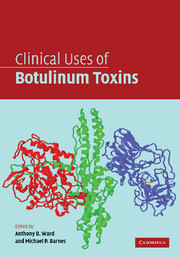Book contents
- Frontmatter
- Contents
- List of Contributors
- 1 Introduction
- 2 Mechanistic basis for the therapeutic effectiveness of botulinum toxin A on over-active cholinergic nerves
- 3 Botulinum toxin: from menace to medicine
- 4 Botulinum toxin: primary and secondary resistance
- 5 Introduction to botulinum toxin in clinical practice
- 6 Cervical dystonia
- 7 The use of botulinum toxin in otolaryngology
- 8 Spasticity
- 9 Hyperhidrosis
- 10 Hypersalivation
- 11 Botulinum toxin type A for the prophylactic treatment of primary headache disorders
- 12 Botulinum toxin in the management of back and neck pain
- 13 Clinical uses of botulinum toxin
- 14 Bladder and bowel indications
- 15 Cosmetic uses of botulinum toxin A
- 16 Other clinical neurological uses of botulinum toxin
- Index
- Plate section
- References
14 - Bladder and bowel indications
Published online by Cambridge University Press: 02 December 2009
- Frontmatter
- Contents
- List of Contributors
- 1 Introduction
- 2 Mechanistic basis for the therapeutic effectiveness of botulinum toxin A on over-active cholinergic nerves
- 3 Botulinum toxin: from menace to medicine
- 4 Botulinum toxin: primary and secondary resistance
- 5 Introduction to botulinum toxin in clinical practice
- 6 Cervical dystonia
- 7 The use of botulinum toxin in otolaryngology
- 8 Spasticity
- 9 Hyperhidrosis
- 10 Hypersalivation
- 11 Botulinum toxin type A for the prophylactic treatment of primary headache disorders
- 12 Botulinum toxin in the management of back and neck pain
- 13 Clinical uses of botulinum toxin
- 14 Bladder and bowel indications
- 15 Cosmetic uses of botulinum toxin A
- 16 Other clinical neurological uses of botulinum toxin
- Index
- Plate section
- References
Summary
Introduction
Botulinum neurotoxin (BoNT) inhibits neuromuscular transmission and it has become a drug with many indications. The range of clinical applications has grown to encompass several neurological and non-neurological conditions. Over the years, the number of primary clinical publications has grown exponentially, and continues to increase every year. Although BoNT blocks cholinergic nerve endings in the autonomic nervous system, it has also been shown that it does not block non-adrenergic non-cholinergic responses mediated by nitric oxide (NO). This has promoted further interest in using BoNT as a treatment for overactive smooth muscles and sphincters (Table 14.1).
Recent clinical experience of BoNT in urological impaired patients will be described in this chapter. Moreover, understanding the anatomical and functional organization of gastrointestinal tract (GIT) innervation is necessary to understand many features of BoNT action on the GIT and the effect of injecting specific sphincters. This chapter presents current data on the use of BoNT to treat GIT diseases and summarizes recent knowledge on the pathogenesis of GIT disorders due to a dysfunction of the enteric nervous system (ENS).
Urinary bladder indications
Anatomy and physiology of micturition
The two functions of lower urinary tract (LUT) are storage and active expulsion of urine. The LUT consists of the bladder (detrusor muscle bundles) and the urethra. The urethra contains a dual sphincter mechanism. The internal sphincter is a smooth muscle part of the vesical neck and posterior urethra with both adrenergic and cholinergic innervation.
- Type
- Chapter
- Information
- Clinical Uses of Botulinum Toxins , pp. 282 - 327Publisher: Cambridge University PressPrint publication year: 2007
References
- 1
- Cited by

